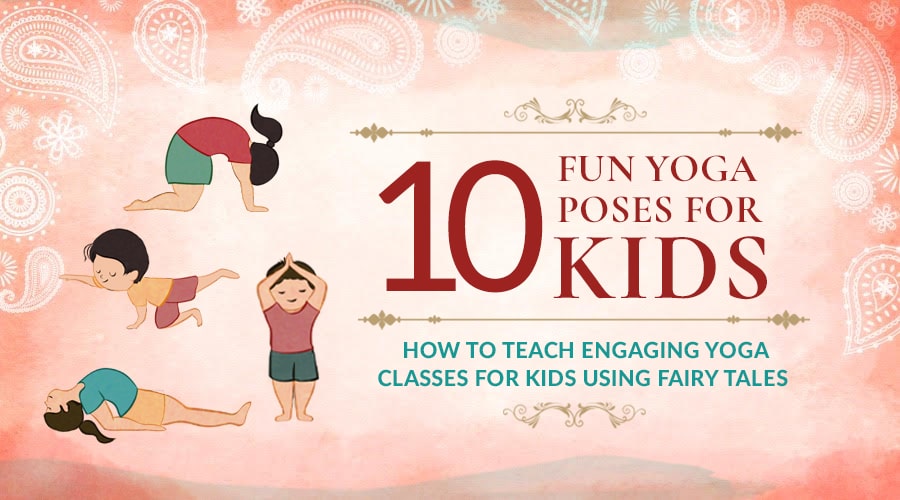Teaching yoga to kids has many benefits. But how do you keep them engaged and motivated during a yoga class? Children often struggle to concentrate for long periods, and getting an entire class to focus on you and the yoga poses can be difficult.
So whether you’re a kids yoga teacher or loving caregiver, this blog will explore the benefits or yoga for children and how best to teach yoga using the power of fairy tales. In the end, I also share 10 fun yoga poses for kids to boost your child’s well-being and love for yoga.
The Benefits of Kids Yoga
Yoga and mindfulness can benefit children’s emotional, mental, and physical wellbeing. Learning yoga from a young age gives children the tools to create a healthy and confident life. When practiced regularly, yoga can also help kids manage symptoms of ADHD, as well as anxiety and depression.
Some other notable benefits of yoga poses for kids include:
- Increasing physical activity and flexibility
- Improving emotional regulation and overall mood
- Managing stress and anxiety
- Boosting self-esteem
- Increasing body awareness and mindfulness
See our guide on the Benefits of Teaching Yoga to Kids & Teenagers to learn more.
However, we all know that no matter how excellent the benefits are, if it's not fun, children won't be interested. That's where you have to get creative!
Using Fairy Tales to Teach Kids Yoga Poses
For children, playing means socializing and movement. It allows them to let go of excess energies and step out of the day-to-day routines that may stress them out. Kids also learn better when playing—they are more likely to listen and remember. And what’s more fun than teaching yoga poses for kids with a fairy tale or story intertwined?
How Do Fairy Tales Keep Kids Engaged?
Using fairy tales or storytelling is a great way to teach kids yoga poses because it:
- Allows them to have fun
- Develops and improves cognitive abilities and literacy
- Teaches kids how to regulate emotions towards themselves and those around them
- Boosts body and breath awareness through body representation of fairy tales
- Teaches essential values such as patience, kindness and hard work
- Brings them into a calm and relaxing mindset where concentration is increased
Even when playing, it’s important to keep kids engaged to benefit from the yoga session and avoid distracting those around them.
Tips for Boosting Engagement in a Kids Yoga Class
Keeping children engaged during your yoga class can be difficult without a well-thought-out plan. Here are a few ways you can get your younger students interested and excited about yoga:
- Use short and straightforward explanations
- Use your body more than your words. Show them what to do and how to have fun
- Keep things interesting by including variety in your games and fairy tales
- Include brief relaxation and guided visualization to explore their senses (touch, sight, hearing, smell and taste)
- Challenge children according to their age and development to keep them motivated
I advise using specific yoga teaching techniques according to children's age groups, as each child is on a different developmental journey and may respond differently. For example, you can incorporate longer relaxations with guided visualizations from age seven. From age eight, you can play less and do more yoga, giving them the freedom to create their yoga sequences.
Now that we've looked at how you can keep children engaged in the yoga class, let's jump into how you can use fairy tales in your class and different yoga poses for kids.
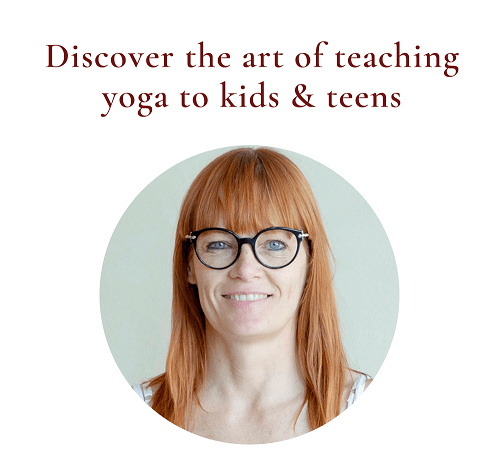
Discover the art of teaching yoga to kids & teens
Get free access to the exclusive podcast with master teacher Marzia Bendotti
The Best Fairy Tales for Kids Yoga Poses
Now is where the fun begins!
First, find a story or fairy tale into which you can incorporate yoga poses. You can even create your own story. This can be a story that includes subjects related to simple yoga poses for kids like a stone, snake, cat, frog or butterfly. By doing this, you can encourage your students to practice all the different asanas represented in the story, such as:
- Stone Pose
- Cobra Pose
- Cat Pose
- Frog Pose
- Butterfly Pose
As you read the story, you prompt the kids to do the yoga pose whenever you mention the character or object. For example, when the story notes how the cat stretches its back, they come into Cat Pose. Remember to follow along and show them with body movements how it's done.
Let’s look at a short fairy tale you can use for children aged 5-7.
The Vain Cat
In this fairy tale, the asanas help to move the spine, relieve tension and promote flexibility. The children are invited to reflect on knowing and accepting their limits during this session.
(See the numbering system below to know where they should incorporate the yoga pose.)
Once upon a time, there was a vain cat who believed he was just as strong as a tiger (1).
One day he got it into his head that he wanted to walk on two legs, as humans do, so he undertook to lift one paw all day (2) and then the other ...
And finally, by means of trying, he succeeded! (3)
He fell immediately but satisfied, he went to sleep, dreaming of being able to swim like a little fish (4)
Asanas (numbering system)
1. Cat Pose
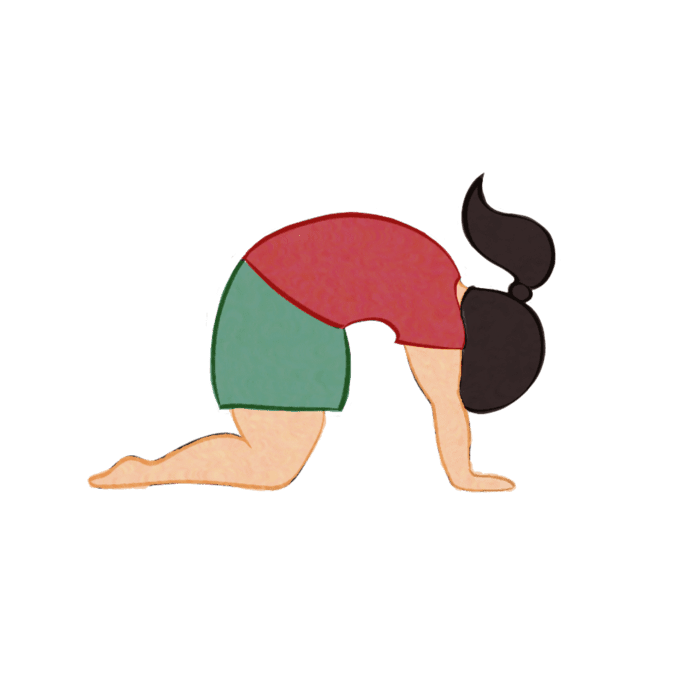
2. Cat Pose with one hand up
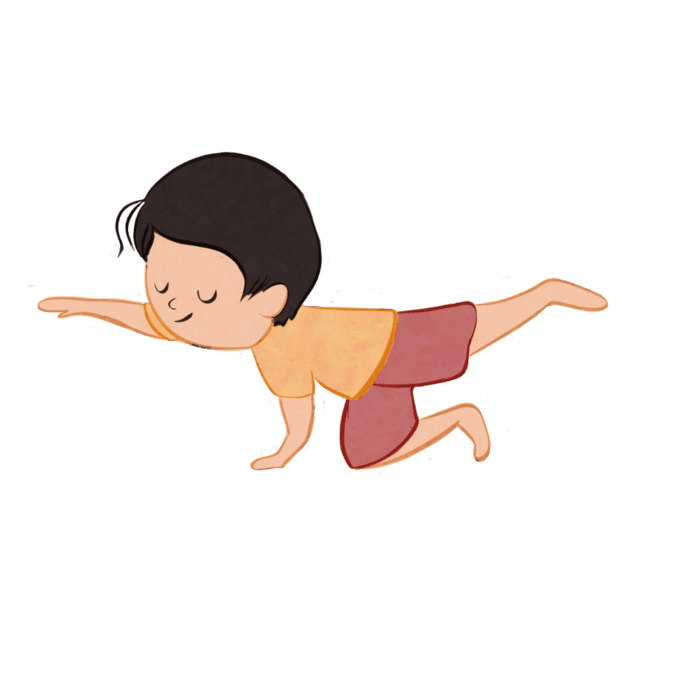
3. Mountain Pose
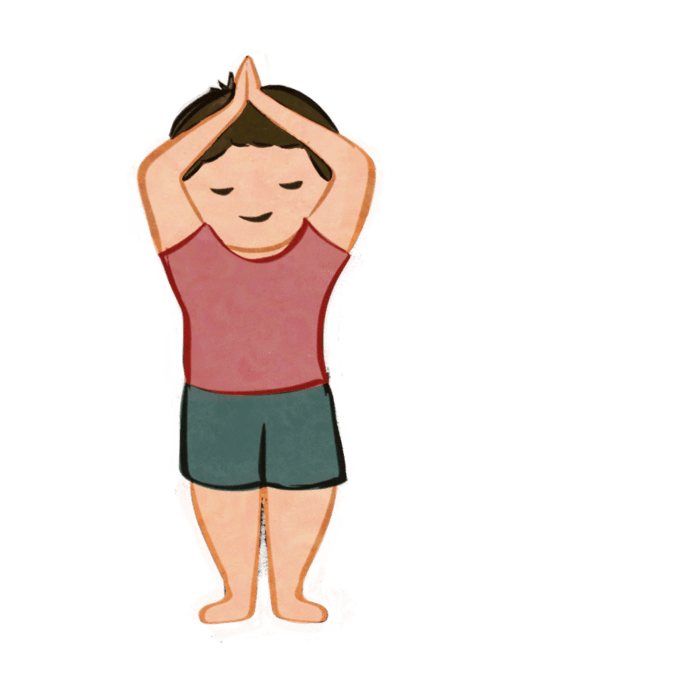
4. Fish Pose
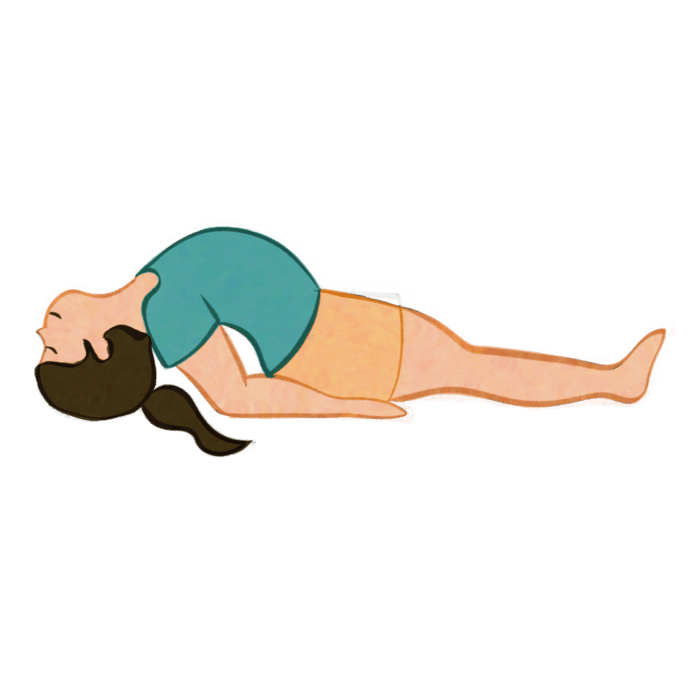
As your students get older, you can challenge them by using longer stories and incorporating more movement and asanas into the yoga practice.
10 Fun & Easy Yoga Poses for Kids
Below are different kids yoga poses and examples of characters or objects you can use for the corresponding asanas. These are only a few examples, so I encourage you to think of more of your favorite asanas and how you can fit them into a fun and educational story.
Downward-Facing Dog Pose (Adho Mukha Svanasana)
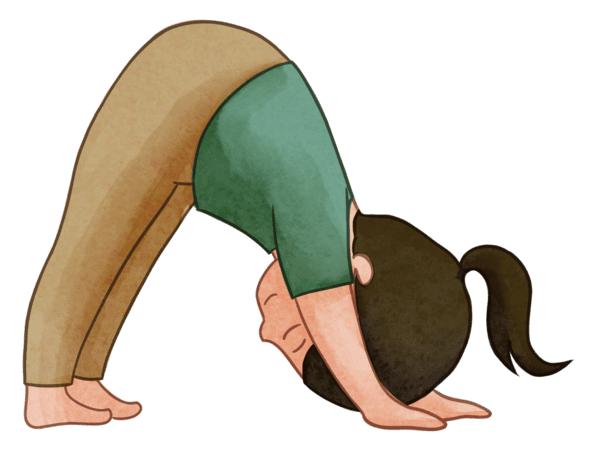
Downward-facing dog is a fun yoga pose for kids as students get to pretend to be a stretching dog while releasing tension in their spine, shoulders, and hamstrings. This pose is also effective for better digestion, flexibility, and strength.
- Encourage your students to stand just like their canine friends on all fours.
- Then, instruct them to straighten their arms and legs while pressing their hands and feet firmly into the ground; like a dog that has woken up from a long nap in the sun.
- Make sure that your students' legs are extended and that their backs and arms are straight. Necks should also be relaxed.
- At this stage, you can make the pose more playful by asking your students to lift one leg up like a tail and move it around as if it’s wagging. They can also put their tongues out like panting dogs and showoff their best bark!
Locust Pose (Salabhasana)
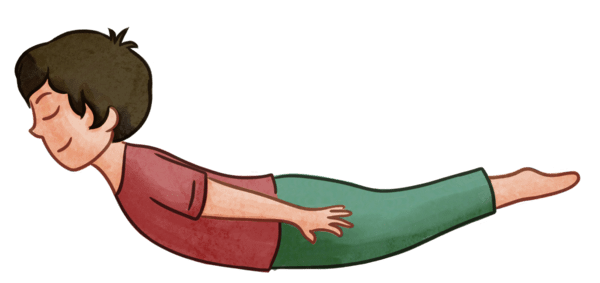
Locust pose, or Salabhasana, can be a fun and engaging yoga pose for kids as it helps them to develop their strength and balance while imitating the posture of a locust. This pose strengthens the back, arms, and legs, and can also help improve posture and reduce stress.
- Your students can begin lying on their stomachs, with legs resting on the floor and arms at their sides.
- Now, instruct them to lift their legs off the ground and extend their arms as far back as they can.
- Once here, encourage them to push further and imagine that they are a locust soaring through the sky!
In a kid’s yoga story, you can use this position to represent an airplane, a leaf flying in the air, or even a superhero.
Tortoise Pose (Kurmasana)
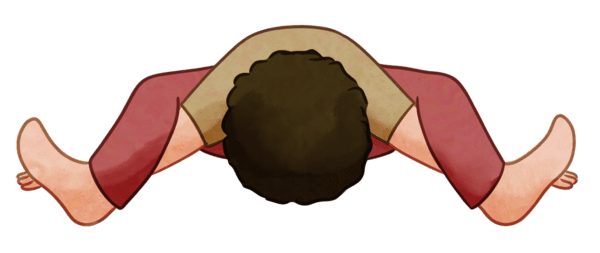
Tortoise Pose calms the mind and increases flexibility in the hips. It also tones the abdominal muscles and strengthens the back.
- Start by having your students sit with their legs apart and knees slightly bent, keeping their feet flat on the floor.
- Now, instruct them to slide their hands and arms under their legs, grabbing their ankles and extending their torso forward.
- Count slowly like a tortoise from 1 to 10, and ask them to close their eyes and walk forward at a snail's pace. They can even move their jaw and chew like a real tortoise!
Child's Pose (Shashankasana / Balasana)
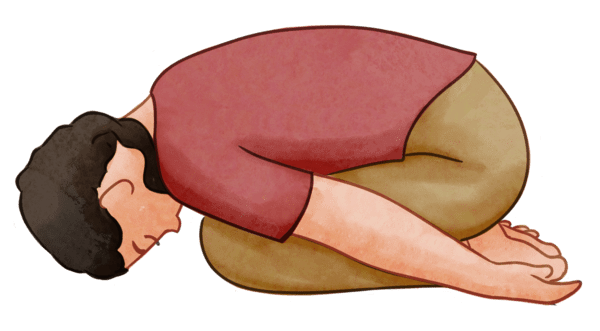
In Child’s Pose, kids can pretend to be a small, cozy ball that gently stretches the back, hips, and thigh. Additionally, this pose can be modified to make it more playful and interactive, such as adding animal sounds or movements.
- Students start on their knees, with feet resting on the floor and bottom on the heels.
- Now, instruct your students to gently fold forward and relax their torsos on their thighs.
- Here, they can pretend their arms are snakes slithering to the top of the mat, or they glue them next to their sides and become a still rock or a big brown bear sleeping in a cave.
Butterfly Pose (Baddha Konasana)
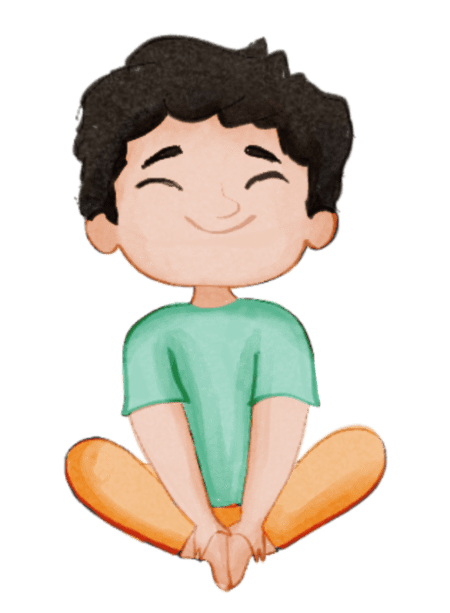
Simple and interactive, Butterfly Pose is one of the best yoga poses for children. By encouraging your little ones to flutter like a butterfly, this pose opens the hips and stretches the thighs and groin. It also stimulates the kidneys and bladder, and boosts concentration and balance.
- Students can start in a comfortable seated position with their legs crossed. Then, ask them to bring the soles of feet together, creating space between the hips and feet.
- Now, instruct them to grab both feet together and flap the knees up and down like the wings of a beautiful butterfly.
- They can form the wings of the butterfly with their arms by placing their hands on their hips.
- From this position, they can grab their foot and slightly extend the leg out to the side, opening the wings of the butterfly.
- To make the position more stimulating, tell your students to tilt their heads slightly and look under their knee to see what color their wings are. If this movement comes easy to them, then they can lift both legs at the same time.
Butterfly Pose Variations:
- Butterfly antennae: Create butterfly antennae with the fingers on the sides of the forehead (students can continue flapping their “wings” with their legs).
- Butterfly landing on a flower: Lean forward and bring the chest towards the feet. Keeping the back straight and see if they can touch their toes with their nose and smell the flower.
For toddlers, it's always better to use pictures (“smelling the flowers”) rather than instructions (“putting noses on toes”). Plus, it's even more fun!
Bridge Pose (Setu Bandhasana)
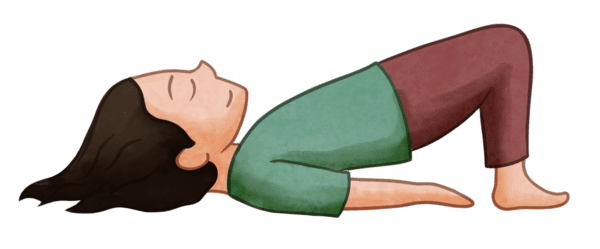
Bridge pose is a great asana for children as it strengthens the back muscles, improves posture, and gives the chest, neck, and spine a rejuvenating stretch. Moreover, it promotes relaxation and aids digestion, making it an effective pose for boosting both physical and mental well-being.
- Start with students lying on the ground, belly up, knees bent, and feet flat. They can extend their arms long next to their sides with fingers pointing downwards.
- Now, ask them to shift their weight onto their feet and lift their hips up into a bridge.
- Be creative and tell your students to imagine there are cars or boats passing under them!
Drawbridge Variation
- In the bridge position, tell your students to lift one leg straight up to the sky and push the other leg firmly into the floor.
- Remind your students to keep their hips lifted and push them even higher, alternating legs.
- Lastly, encourage them to lift and lower their pelvis, like a bridge opening and closing to allow boats to pass through a canal.
Lizard Pose
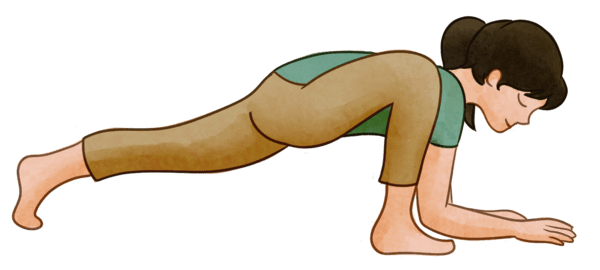
Lizard Pose is a wonderful kids' yoga posture that has numerous benefits such as opening up the hips and building strength in the legs. Here are the steps to do the Lizard Pose:
- Begin on all fours in a tabletop position, with your wrists under your shoulders and your knees under your hips.
- Step your right foot forward and place it next to your right hand, making sure your knee is directly above your ankle.
- Slowly lower your left knee down to the ground, keeping the top of your left foot on the mat.
- Begin to walk your hands forward, lowering your forearms to the ground, if possible. You can also keep your hands on the ground if this is too intense.
- Sink your hips down towards the ground, feeling a stretch in your right hip flexors and left hip extensors.
- Hold the pose for several deep breaths, then release and repeat on the other side.
Play around and get creative with your own story or use an existing fairy tale.
Need more inspiration for yoga poses? Read Yoga Exercises – Yoga Asana Guide.
Even though these poses and fairy tales will be the basis of your yoga class, other parts, such as breath work and relaxation, are still important. You'll need a well-structured yoga class to ensure optimal flow and engagement.
How Do You Structure a Kids Yoga Class
Having a structure for your kids' yoga class ensures that you cover all aspects of yoga in a balanced and safe manner. This can help prevent injury and ensure that the children receive the full benefit of their yoga practice. As a yoga teacher, it also helps you stay on track and keep your students focused and engaged throughout the class. Here is what a typical kids' yoga class should look like:
1. Opening/Closing Ritual
A ritual is activities that are repeated in a set, precise manner. In each class, the opening and ending should be more or less the same. This repetition of the ritual allows the children to become mindful and calm.
2. Warm-up
Now we do exactly as the word says; we warm up the body and mind. This part includes a simple series of movements to activate the muscles and brain. The warm-up allows the kids to start moving and inspires positive and creative thinking.
3. Games and Fairy Tales
As I’ve mentioned before, fairy tales are excellent for teaching kids yoga poses as it helps keep them engaged and motivated.
4. Breathing Exercises
Pranayama and deep breathing help kids calm down and reduces stress, just like it does with adults. However, teaching kids how to take deep belly breaths is often more complex. Therefore, it's important to show them what to do. Do not merely tell them but remember to use your body more than your words.
Try these 3 Yogic Breathing Exercises to Calm Down.
5. Final Relaxation
A relaxed child is a happy child! End your yoga class with relaxation techniques to bring them into the present moment.
Conclusion
If you’ve found this brief guide on how to teach yoga poses for kids exciting and would love to know more, you’re in luck! We have a 50-hour Teen & Kids Yoga Teacher Training course that will empower you to create comprehensive, engaging and fun Kids Yoga classes. After the course, you’ll be a Certified Kids’ Yoga Teacher. Find out more here.

